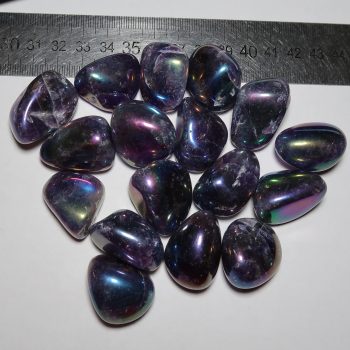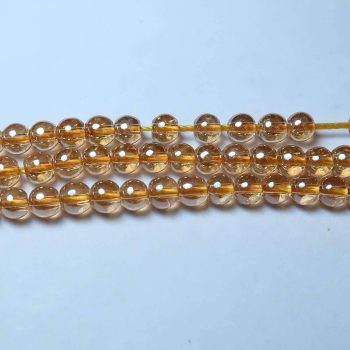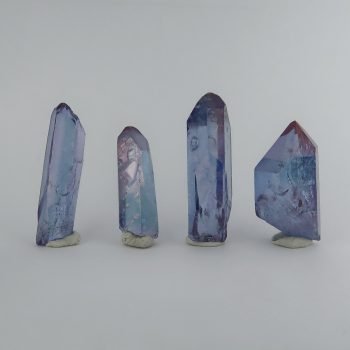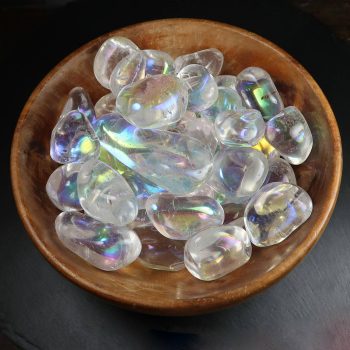Aura Treated Crystals (Synthetic)
Aura treated crystals are an oddity – ordinary natural crystals which have been artificially coated in a thin layer of metal film to produce iridescent colours.
The process itself is called physical vapour deposition.
Showing all 4 results
-

Aura Amethyst Tumblestones
£2.50 -

Aura bead strands
£10.00 -

Aura Quartz Points
Price range: £2.00 through £4.00 -

Aura Quartz Tumblestones
Price range: £2.00 through £2.50
Appearance, Uses, and History
Aura crystals are an odd little thing. Essentially, what they are is a material that has been coated with a very thin layer of metals.
To call them aura ‘crystals’ is not always accurate – in some cases, the metal film has been plated over glass. It is, of course, difficult to distinguish the material after it has been plated!
This process isn’t something you can do in a kitchen – it is definitely a laboratory procedure. Quartz crystals are heated in a vacuum chamber to around 900c before Gold vapour is added to the chamber – the Gold vapour then bonds to the surface of the Quartz, giving an iridescent sheen.
Various colours are possible, although there isn’t much information online regarding the specific metals required for each colour. Some metals that are used include Gold, Indium, Titanium, Niobium, and Copper.
There are numerous trade names for these aura coated crystals, including ‘angel aura’, ‘rainbow aura’, ‘titanium quartz’, ‘lemon quartz’, ‘celestial aura’, ‘opal aura’, ‘champagne aura’, ‘sunshine aura’, ‘aqua aura’, ‘titanium aura’, ‘rose aura’, ‘flame aura’, and ‘ruby aura’.
Combinations of colour names in front of the word ‘aura’ are common, too, as is the use of ‘AB’ in the name – which refers to Aurora Borealis, a type of colour reflecting rhinestone.
It can be difficult to find accurate information on these pieces, as the pieces are made in Chinese labs and their particular method may be a secret.
Hazards and Warnings
Almost all rocks, minerals (and, frankly, almost all other substances on earth) can produce toxic dust when cutting, which can cause serious respiratory conditions including silicosis.
When cutting or polishing rocks, minerals, shells, etc, all work should be done wet to minimise the dust, and a suitable respirator or extraction system should be used.
I would assume there are hazards to the metal vapour deposition processed used to create these crystals – but they aren’t something you would be repeating at home anyway!
Translations
Arabic:
- كريستال هالة
Hindi:
- आभा क्रिस्टल
Portuguese:
- cristal de aura
Bengali:
- অরা স্ফটিক
Indonesian:
Punjabi:
English:
Italian:
- cristallo aura
Russian:
- аура кристалл
French:
- cristal d’aura
Japanese:
- オーラクリスタル
Spanish:
- cristal de aura
German:
- Aura Kristall
Korean:
Thai:
Gujurati:
Mandarin and Traditional Chinese:
- 光环水晶
Urdu:
